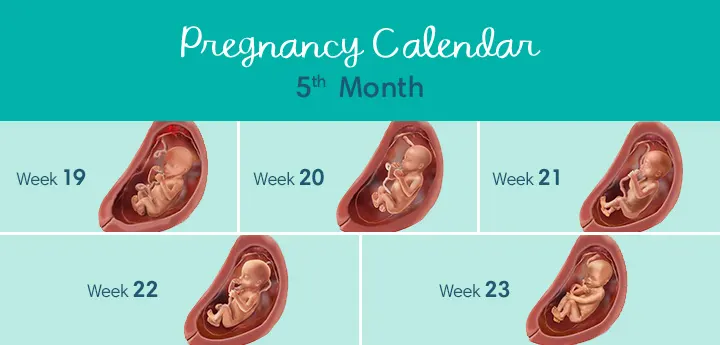5 Months Pregnant
Though each mom-to-be’s body changes in different ways throughout pregnancy, your baby belly might be visible by the time you’re 5 months pregnant. This month, you’ll likely be adjusting to the physical changes that come with a growing bump and your changing center of gravity. Read on to learn about common pregnancy symptoms at 5 months, what happens at the mid-pregnancy ultrasound, how your baby is developing, and more!
Common Pregnancy Symptoms at 5 Months Pregnant
Here's hoping that you are still enjoying the energy boost that the second trimester is famous for. It's also possible that you’re experiencing some pesky symptoms at 5 months pregnant. These can include:
Swollen feet. Pregnancy weight gain, fluid retention, and the pregnancy hormone relaxin might be causing this symptom at 5 months pregnant. Relaxin loosens the muscles in your body in preparation for childbirth and it also loosens the joints in your feet, making your feet expand. A cool foot bath can help relieve some of the swelling. Putting your feet up might also help.
Lower back pain. At 5 months pregnant, your posture may start to change as you adjust to your growing belly. As your bump grows, your center of gravity shifts. This can cause some strain on your lower back, as your muscles must work extra hard to support this extra weight and your changing body shape. Try exercises that strengthen your back muscles, and make sure you sit in chairs with good back support—or prop a pillow behind you. If your back pain is causing too much discomfort, get help from your healthcare provider.
Dizziness. As your little one grows, your blood circulation can change, resulting in less blood flow to your head. This can cause that woozy feeling when you stand up or suddenly change positions. Be careful and take things slowly and avoid being on your feet when you feel dizzy.
Nasal congestion. Stuffy nose? Nosebleeds? Or maybe a runny nose? These issues can be caused by pregnancy hormone, which can dry out the mucous membranes in your nasal passages. Saline drops might help relieve some of the congestion. Running a humidifier in your bedroom at night can also help.
“Pregnancy brain.” If you keep losing your keys or can’t remember your phone’s password, don’t worry—this forgetfulness is known to happen during pregnancy. Although it’s not an official medical condition, it’s quite common. Many healthcare providers associate this absentmindedness with hormonal changes, stress, or sleep deprivation. Try making lists or using scheduling apps if you’re worried about forgetting something important.
Difficulty sleeping. At 5 months pregnant and beyond a bigger bump can make it harder to find a comfortable sleeping position. Try lying on your side with a pillow between your knees and a pillow under your belly for extra support. Regular exercise such as walking, swimming, or prenatal yoga and taking a warm, soothing bath before bed may help you get a better night’s sleep.
Braxton Hicks contractions. It’s possible you’ll start to experience these “practice” contractions this month. These can feel like a mild tightening or a more painful cramping in your abdomen. You’re more likely to feel them later in the day, or after exercise or sex. Sometimes you may be unsure whether what you’re experiencing is Braxton Hicks or real labor contractions. Typically, Braxton Hicks go away if you move or change positions, but if you’re at all uncertain about what you are feeling, contact your healthcare provider.
RELATED PREGNANCY TOOL
Baby Name Generator
Filter by gender:
Filter by theme:
How Is Your Baby Developing This Month?
Your little one might be becoming a little more active this month, with the kicks and flips finally becoming noticeable. Your baby is beginning to sleep and wake up at regular intervals, and she may even be awakened by outside noises, so don’t be surprised if you feel a reaction after a loud sound.
Your little one’s skin begins to produce both vernix and lanugo this month. Vernix is a slick, greasy coating that protects the skin while in the amniotic sac, and it will completely cover her body when she’s born.
Lanugo is soft, fine hair that helps hold the vernix in place on the skin. Most of this lanugo will disappear before birth, but some babies are born with small patches on various parts of the body.
By the end of this month, your little one may be a thumb sucker, as the sucking reflex starts to kick in in preparation for feeding once born.
How Big Is Your Baby When You’re 5 Months Pregnant?
Your baby grows from being about 5 inches long and weighing about 5 ounces, to being about 10 inches long and weighing about 1 pound around this month.
All this means, when you’re 5 months pregnant, your baby’s size is like that of a bell pepper or a banana. You’ve both come a long way in five months!
What Does a Fetus Look Like at 5 Months?
Check out these illustrations for a glimpse at what your baby might look like when you’re 5 months pregnant:
Getting an Ultrasound at 5 Months Pregnant
Most moms-to-be have at least one ultrasound during pregnancy and this usually occurs at 5 months pregnant—at around 18 to 20 weeks.
At the standard mid-pregnancy ultrasound, your healthcare provider:
Estimates your baby’s gestational age
Estimates your baby’s weight
Checks that your baby is developing normally, including that your baby’s heart, head, and spine are forming as they should
Checks for conditions like placenta previa (which is a rare condition in which the placenta lies low in the uterus and partially or completely covers the cervix) or placenta accreta (a very rare condition where the placenta grows too deeply into the uterine wall and can’t easily separate away after your baby is born)
Checks your baby’s position, movement, and heart rate
Checks the amount of amniotic fluid surrounding your baby in the uterus
Checks whether you are carrying multiples.
Although an ultrasound exam is a medical tool, your healthcare provider may be able to tell you whether you’re having a boy or girl, if this is something you’d like to find out. Your healthcare provider will be able to tell you whether any other ultrasounds need to be scheduled during your pregnancy. Sometimes additional ultrasounds are needed to check for a specific condition or as part of a medical test.
Consult your healthcare provider if you’re curious about having a more detailed 3D or 4D ultrasound scan.
Pregnant With Twins
If, during the ultrasound, you discovered you’re carrying twins or more, it might come as quite a big shock and it can take a little time to adjust to the fact that you’ll be taking home more than one baby.
It’s natural to have lots of questions about the different types of twins, how a twin pregnancy may be different, and how you can prepare. Read our FAQ on twin pregnancy for more on this topic. Don’t be afraid to ask your healthcare provider or midwife lots of questions, and perhaps find other parents of twins in your area so that you have a network of people to speak to who understand your unique pregnancy and parenting journey.
5 Months Pregnant: Your Body’s Changes
So, can you feel your baby at 5 months pregnant? Yes! At some point during this month, you may feel your little one move for the first time. This is called quickening, and some moms-to-be detect these sensations at around 18 weeks of pregnancy.
If this isn’t your first baby, you may start to sense these movements earlier than you did with your first baby because you’re more familiar with the feeling. If you haven’t felt those first flutters yet, try to be patient. It may still be several weeks before your little one’s kicks are noticeable.
If you are feeling those flutters, your healthcare provider may soon recommend that you begin doing daily "kick counts." Download our fetal movement tracker and talk to your provider about when and how to count those little kicks.
At your prenatal checkups from 5 months pregnant onward (if not earlier), your healthcare provider may start checking your belly size by measuring your fundal height. The fundal height is measured in centimeters from your pubic bone to the top of your uterus.
Interestingly, your fundal height usually closely corresponds to the number of weeks pregnant you are. So, if you’re 18 weeks pregnant, your fundal height is likely to be around 18 centimeters.
How Far Along Are You at 5 Months Pregnant?
This month fits squarely into the second trimester, but you may be wondering how many weeks of pregnancy you’re up to at 5 months pregnant?
There are a few different ways the weeks of pregnancy are grouped into months, so this fifth month could range from week 17 or 18 up to week 20, 21, or 22.
FAQS AT A GLANCE
One good strategy is to say something like "Thank you—good to know," and then leave it at that. Although comments or questions from friends and strangers are usually well-intended, the details of your pregnancy are between you and your healthcare provider and those with whom you want to share details.
Checklist for When You’re 5 Months Pregnant
If you’ve just found out whether you’re having a boy or girl and would love to share the news in an extra special way, why not hold a gender reveal party?
If you now know your baby’s gender, it might have thrown a spanner in the works in terms of your baby’s name choice. For example, if you had a favourite girl’s name in mind but have just found out you’re having a boy, you might feel like you’re right back at square one. Don’t worry, there’s still lots of time to find the right name and our Baby Name Generator can help.
Ask your healthcare provider whether you have any of the risk factors for gestational diabetes and whether a glucose screening test is right for you.
Check with your provider about whether you have any of the risk factors for the high blood pressure disorder called preeclampsia and find out what steps you can take to reduce the risks associated with this condition.
Get a flu shot if you haven’t already. The shot is safe to get at any time during your pregnancy. Schedule a dentist checkup if you haven’t had one since the start of your pregnancy.
Start shopping for maternity clothes and bras, if needed.
Plan a babymoon! If you’re feeling up to it, this is a great time to travel. Just check with your healthcare provider first.
Consider if you want to draft a birth plan for your labour and delivery and start thinking about your preferences. Make time to talk to your midwife and healthcare provider about what to include and what your options may be.
If you’re feeling energetic, take advantage of this time to design and prepare your baby’s nursery. If you need some inspiration, check out these nursery theme and decoration ideas.
Sign up for prenatal classes. There may be childbirth, breastfeeding, or parenting classes available in your area. Ask your healthcare provider and other parents for recommendations. Keep in mind that you may need to register ASAP to get a spot in your preferred class.
For a look at what’s to come in the final months of your pregnancy, download our third trimester guide.
Sign up for even more weekly pregnancy tips here:
5 month old baby - checklist
The information in this article is based on the expert advice found in trusted medical and government sources, such as the American Academy of Pediatrics and the American College of Obstetricians and Gynecologists. You can find a full list of sources used for this article below. The content on this page should not replace professional medical advice. Always consult medical professionals for full diagnosis and treatment.



